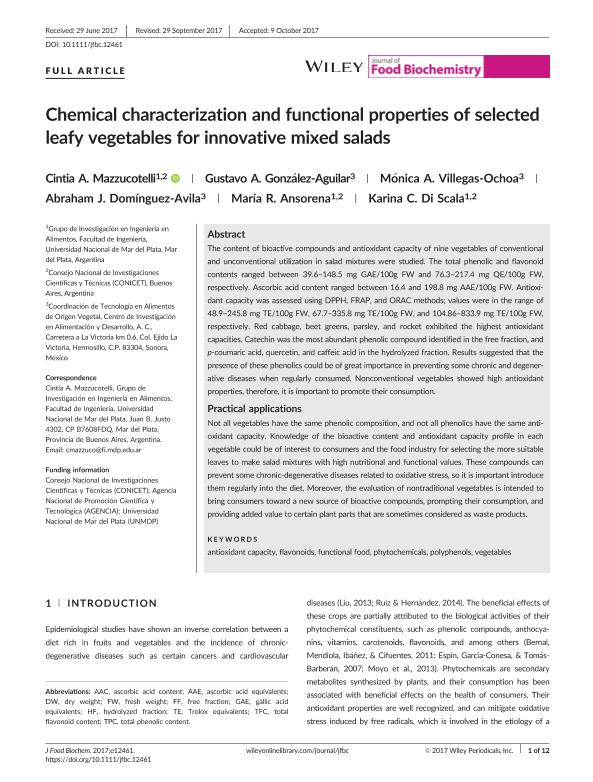Mostrar el registro sencillo del ítem
dc.contributor.author
Mazzucotelli, Cintia Anabela

dc.contributor.author
González Aguilar, Gustavo A.
dc.contributor.author
Villegas Ochoa, Mónica A.
dc.contributor.author
Domínguez Avila, Abraham J.
dc.contributor.author
Ansorena, Maria Roberta

dc.contributor.author
Di Scala, Karina Cecilia

dc.date.available
2018-08-14T16:40:45Z
dc.date.issued
2018-02
dc.identifier.citation
Mazzucotelli, Cintia Anabela; González Aguilar, Gustavo A.; Villegas Ochoa, Mónica A.; Domínguez Avila, Abraham J.; Ansorena, Maria Roberta; et al.; Chemical characterization and functional properties of selected leafy vegetables for innovative mixed salads; Wiley Blackwell Publishing, Inc; Journal Of Food Biochemistry; 42; 1; 2-2018; 1-12; e12461
dc.identifier.issn
0145-8884
dc.identifier.uri
http://hdl.handle.net/11336/55380
dc.description.abstract
The content of bioactive compounds and antioxidant capacity of nine vegetables of conventional and unconventional utilization in salad mixtures were studied. The total phenolic and flavonoid contents ranged between 39.6–148.5 mg GAE/100g FW and 76.3–217.4 mg QE/100g FW, respectively. Ascorbic acid content ranged between 16.4 and 198.8 mg AAE/100g FW. Antioxidant capacity was assessed using DPPH, FRAP, and ORAC methods; values were in the range of 48.9–245.8 mg TE/100g FW, 67.7–335.8 mg TE/100g FW, and 104.86–833.9 mg TE/100g FW, respectively. Red cabbage, beet greens, parsley, and rocket exhibited the highest antioxidant capacities. Catechin was the most abundant phenolic compound identified in the free fraction, and p-coumaric acid, quercetin, and caffeic acid in the hydrolyzed fraction. Results suggested that the presence of these phenolics could be of great importance in preventing some chronic and degenerative diseases when regularly consumed. Nonconventional vegetables showed high antioxidant properties, therefore, it is important to promote their consumption. Practical applications: Not all vegetables have the same phenolic composition, and not all phenolics have the same antioxidant capacity. Knowledge of the bioactive content and antioxidant capacity profile in each vegetable could be of interest to consumers and the food industry for selecting the more suitable leaves to make salad mixtures with high nutritional and functional values. These compounds can prevent some chronic-degenerative diseases related to oxidative stress, so it is important introduce them regularly into the diet. Moreover, the evaluation of nontraditional vegetables is intended to bring consumers toward a new source of bioactive compounds, prompting their consumption, and providing added value to certain plant parts that are sometimes considered as waste products.
dc.format
application/pdf
dc.language.iso
eng
dc.publisher
Wiley Blackwell Publishing, Inc

dc.rights
info:eu-repo/semantics/openAccess
dc.rights.uri
https://creativecommons.org/licenses/by-nc-nd/2.5/ar/
dc.subject
Antioxidant Capacity
dc.subject
Flavonoids
dc.subject
Functional Food
dc.subject
Phytochemicals
dc.subject
Polyphenols
dc.subject
Vegetables
dc.subject.classification
Alimentos y Bebidas

dc.subject.classification
Otras Ingenierías y Tecnologías

dc.subject.classification
INGENIERÍAS Y TECNOLOGÍAS

dc.title
Chemical characterization and functional properties of selected leafy vegetables for innovative mixed salads
dc.type
info:eu-repo/semantics/article
dc.type
info:ar-repo/semantics/artículo
dc.type
info:eu-repo/semantics/publishedVersion
dc.date.updated
2018-08-13T17:25:00Z
dc.journal.volume
42
dc.journal.number
1
dc.journal.pagination
1-12; e12461
dc.journal.pais
Reino Unido

dc.journal.ciudad
Londres
dc.description.fil
Fil: Mazzucotelli, Cintia Anabela. Universidad Nacional de Mar del Plata. Facultad de Ingeniería. Departamento de Ingeniería Química. Grupo de Investigación en Ingeniería en Alimentos; Argentina. Consejo Nacional de Investigaciones Científicas y Técnicas; Argentina
dc.description.fil
Fil: González Aguilar, Gustavo A.. Centro de Investigación en Alimentación y Desarrollo; México
dc.description.fil
Fil: Villegas Ochoa, Mónica A.. Centro de Investigación en Alimentación y Desarrollo; México
dc.description.fil
Fil: Domínguez Avila, Abraham J.. Centro de Investigación en Alimentación y Desarrollo; México
dc.description.fil
Fil: Ansorena, Maria Roberta. Universidad Nacional de Mar del Plata. Facultad de Ingeniería. Departamento de Ingeniería Química. Grupo de Investigación en Ingeniería en Alimentos; Argentina. Consejo Nacional de Investigaciones Científicas y Técnicas; Argentina
dc.description.fil
Fil: Di Scala, Karina Cecilia. Universidad Nacional de Mar del Plata. Facultad de Ingeniería. Departamento de Ingeniería Química. Grupo de Investigación en Ingeniería en Alimentos; Argentina. Consejo Nacional de Investigaciones Científicas y Técnicas; Argentina
dc.journal.title
Journal Of Food Biochemistry

dc.relation.alternativeid
info:eu-repo/semantics/altIdentifier/doi/http://dx.doi.org/10.1111/jfbc.12461
dc.relation.alternativeid
info:eu-repo/semantics/altIdentifier/url/https://onlinelibrary.wiley.com/doi/abs/10.1111/jfbc.12461
Archivos asociados
